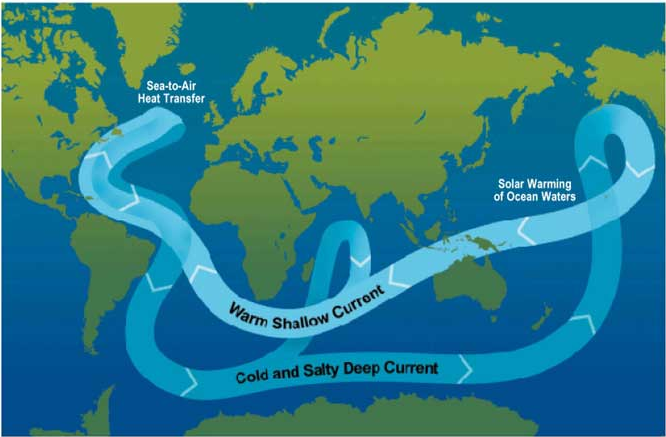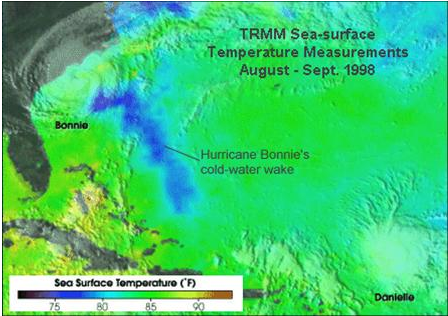Many of the hypotheses about the reasons for the transition to an equable climate focus on the ability of the ocean to transport heat to the high latitudes. If the ocean were able to transport more heat from the Tropics to the poles, then the temperature in the high-latitudes would increase, while the low-latitudes would remain at roughly the same temperature. According to Kerry Emanuel (2002), the amount of vertical mixing that occurs in the ocean controls the magnitude of ocean heat transport. Therefore, if the mixing increased, the ocean would transport more heat to the northern latitudes. As a result, Emanuel suggests that more frequent tropical cyclones could have magnified mixing to a high enough level to have caused the equable climate.

Tropical cyclones cause vertical mixing in the ocean. (Image courtesy of the National Park Service)
Scientists have observed that hurricanes cause turbulence in the ocean and, as a result, instigate mixing of different layers of water (Emanuel, 2002). Therefore, if a mechanism caused more hurricanes to form, the ocean would be mixed more frequently. During the Paleocene-Eocene Thermal Maximum, greenhouse gas concentrations were higher than modern-day levels (Sluijs, 2006). These gases could have forced temperatures to rise, more evaporation to occur, and the amount of water vapor in the air to increase. Both the higher temperature and the increase in moisture in the atmosphere would promote more tropical cyclones to form. This development would cause the ocean to mix more and would increase the ocean heat transport in the thermohaline circulation (THC), the large-scale circulation driven by ocean density gradients.
Why would the THC bring warm water to the poles? Density differences drive the circulation. The colder and the saltier water is, the denser it is. Because a dense fluid will settle at equilibrium beneath another fluid that is less dense, cold and salty water will want to sink to the bottom of the ocean, while warm, fresh water will want to rise to the surface. Think about oil and water. If they are mixed together in a container, the oil will eventually float to the top, while the water will sink to the bottom because it is denser than the oil. This process explains the basics to the THC. Cold, salty water sinks to the bottom of the ocean in the northern Atlantic Ocean. Because this water vacates a space on the surface, water from the south must move up along the surface of the ocean to take is place. Similarly, this water from the south needs to be replaced, so water from the depths of the ocean comes to the surface in the Tropics and warms up as it reaches the surface. Because it is then warm, this water can float on top of the colder layers below it until it reaches the North Atlantic, becomes cold again, and sinks to restart the cycle.

The Thermohaline Circulation is driven by density differences. (Image courtesy of the National Environmental Satellite, Data, and Information Service)
Vertical mixing in the Tropics by tropical cyclones can affect the THC and increases the ocean heat transport because it redistributes water in ways that results in cold, salty water being on top of warm, fresh water. In this situation, the water wants to rearrange itself to disperse the heat from the warm water at depth and to allow this less dense water to return to being on top of the denser, cold water. Additionally, because of the mixing, tropical cyclones are often followed by cold wakes on the sea surface, meaning patches of cold water from the deep ocean rise to the surface. To return to normal conditions, a net influx of heat must occur on the sea surface, and that influx must be balanced by lateral export by the ocean in the long run (Emanuel, 2002). The following equation explains this correlation between vertical mixing and lateral heat flux:
F ~ P2/3B2/3
where F is the lateral heat flux by the ocean, P is the power expended in vertical mixing, and B is the total buoyancy gradient at the sea surface. When mixing occurs, the buoyancy gradient increases. Therefore, the lateral heat flux increases as well. This fact means that mixing promotes the flow of heat from the Tropics to the poles along the sea surface to appropriately redistribute the water according to its density. Hence, if the frequency of tropical cyclones increased, mixing also would increase, and much more heat would reach the high-latitudes. This scenario could lead to the formation of an equable climate.

Hurricane Bonnie left a cold water wake in 1998. (Image courtesy of NASA)
This theory then seems to be a plausible explanation for equable climates. It explains how the high-latitudes became warmer while the low-latitudes did not change drastically. It states that tropical cyclones caused more vertical mixing, which increased the lateral heat flux toward to poles. This greater heat flux warmed the poles while not affecting the temperature in the Tropics. As long as the initial assumption that more tropical cyclones would increase vertical mixing holds, Emanuel's theory appears to provide a reasonable explanation for the equable climate of the Eocene.
Further investigations into this theory, however, reveal that Emmanuel's theory does not accurately describe the way in which tropical cyclones affect the climate. While cyclones increase OHT, the heat does not reach the poles, and, thus, it seems unlikely that tropical cyclones caused the poles to warm substantially (Sriver and Huber, 2007). Additionally, work by Jansen and Ferrari reveals that tropical cyclones actually cause some heat to flow toward the equator and reduce the amount flowing toward the poles (2009). To learn more about these other studies, click here.
